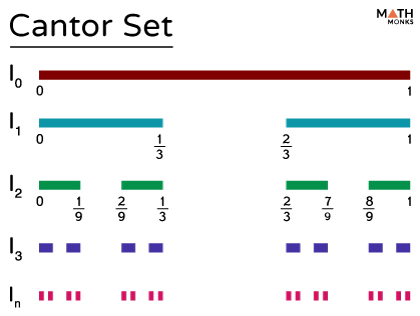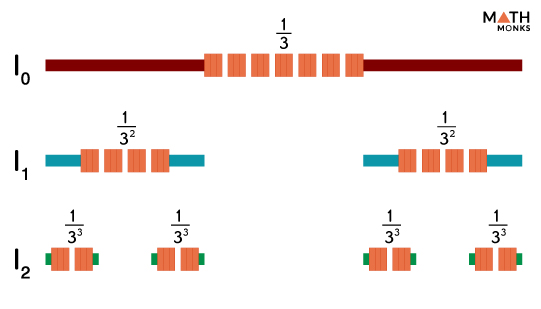The Cantor C∞, or the Cantor comb or no middle third set, consists of points in a line segment. It is written by taking some intervals, for example, [0, 1], and repeatedly removing the middle third of each remaining segment. It is a thus closed set consisting entirely of boundary points.
It was introduced by German mathematician Georg Cantor in 1883.
Construction
Here are the steps to prepare a Cantor set (C) for the line segment with the interval [0, 1]:
- Initial Division: Dividing the interval [0, 1] into three subintervals and removing the open middle-third subinterval ${\left( \dfrac{1}{3},\dfrac{2}{3}\right)}$.
- Subsequent Divisions: Dividing each of the two resulting intervals into three subintervals by removing the open middle-third subintervals ${\left( \dfrac{1}{9},\dfrac{2}{9}\right)}$ and ${\left( \dfrac{7}{9},\dfrac{8}{9}\right)}$.
- Continuing Indefinitely: Continuing this procedure indefinitely by removing the open middle-third subintervals of each interval obtained in the previous step.
We can obtain two copies if we magnify the cantor set from the third step.
If we continue the removal procedure indefinitely, many other points or dust will remain, which is scattered in some ways. Thus, the dust is bound together.
Now, let us describe different ways to measure the remaining dust. This will involve several mathematical applications, such as set theory, measure theory, topology, geometric measure theory, and real analysis.
Ternary Expansion of Cantor Set
The cantor set C consists of the real numbers in the interval [0, 1] whose ternary expansions (base-3) contain only the digits 0 and 2.
Examples
The golden ratio ɸ = 1.618033988… and Euler’s number e = 2.718281828… are decimal representations (base-10) of numbers.
In binary representation (base-2), these numbers can be written using two digits: 0 and 1
Similarly, in ternary or base-3 expansions using three digits (0, 1, 2):
The fraction N (base-3) is written as N = 0.c1c2c3… and is expressed in decimal as
N = 0.c1c2c3… = c1b-1 + c2b-2 + c3b-3 + …
Here, 0 ≤ ci < 3
- The golden ratio ɸ = 1.12120011…3
- The Euler’s number e = 2.20110112…3
The Cantor set in ternary expansion includes:
- ${\dfrac{1}{3}=0.02222\ldots}$
- ${\dfrac{2}{3}=0.20000\ldots}$
- ${\dfrac{1}{9}=0.00222\ldots}$
…
Thus, the Cantor set contains only numbers whose ternary expansion includes 0 and 2.
Formula
Mathematically, the cantor set is expressed by the formula:
C = {x ∈ [0, 1] | x = (0.c1c2c3…cn…)3, where cn = 0 or 2}
Properties
In Measure Theory
The cantor set is negligible, which means its length or Lebesgue measure is 0.
Proof
The Cantor set is created by successively removing intervals. By measuring the removed intervals, we observe that at each step, the number of intervals doubles, and their length decreases by a factor of 3.
Total length of the removed intervals = ${\dfrac{1}{3}+2\cdot \dfrac{1}{3^{2}}+2^{2}\cdot \dfrac{1}{3^{3}}+\ldots =\sum ^{\infty }_{n=0}2^{n}\cdot \dfrac{1}{3^{n+1}}=\ldots =1}$, the geometric sum has its well known solution.
The proportion remaining in the Cantor set is 1 − 1 = 0, indicating the set is negligible.
Thus, the cantor set is measurable, and its length is 0, which means the set contains no intervals of nonzero length.
In Topology
Theorem
The cantor set has no interior points.
Proof
Since the cantor set has a length of 0, it contains no intervals of nonzero length or no continuous parts.
Thus, int(C) = ɸ, and the set has no interior point.
Theorem
The cantor set is closed.
Proof
The Cantor set is formed by removing open middle-third intervals from [0, 1]. This set complements these open intervals, which makes it closed.
Theorem
The cantor set is nowhere dense.
Proof
The Cantor set is the intersection of closed sets and is itself closed, making it nowhere dense.
Theorem
The cantor set is bounded.
Proof
Since the set lies within the interval [0, 1], it is bounded on the interval [0,1].
Moreover, a set bounded and closed in intervals is called a compact set. Thus, C is a compact set.
Theorem
The cantor set has no isolated points.
Proof
While forming the new interval In + 1 from each trisection of In, we obtain another point on the cantor set. Since there always exists a point from the cantor set within any neighborhood of its point, the set has no isolated points.
For example,
If a = 0.00202…3 ∈ C, we get another point very near to ‘a,’ say b = 0.00222…3 ∈ C
Moreover, a compact set with no isolated points is called a perfect set. Thus, C is a perfect set.
Theorem
The cantor set is totally disconnected.
Proof
The Cantor set can be divided into disjoint closed neighborhoods, indicating it is totally disconnected.
From the above example, we have a = 0.00202…3 ∈ C and b = 0.00222…3 ∈ C
It implies that if the cantor set is divided into two disjointed and closed neighborhoods of A and B, one contains ‘a’ and the other contains ‘b.’
Thus, the neighborhood of A contains all elements of C whose 4th digit is 0, and the neighborhood of B contains all elements of C whose 4th digit is 2.
In Set Theory
Theorem
The cantor set is non-empty.
Proof
While forming the new interval In + 1 from each trisection of In, we get exactly two endpoints.
For example,
Removing ${\left( \dfrac{1}{3},\dfrac{2}{3}\right)}$ from [0, 1] leaves the points P0 = ${\dfrac{1}{3}}$ and P1 = ${\dfrac{2}{3}}$
Since the cantor set C is the infinite intersection of each In, it contains the endpoints of each subinterval.
Thus, it is non-empty and infinite.
Theorem
The cantor set is uncountable.
Proof
Since the cantor set contains all endpoints of the removed intervals, it is infinite and consists of more than countably many such points.
Thus, it is uncountable.
Theorem
The Cantor set has the same cardinality as the interval [0, 1]
Proof:
Let us define a function f: C → [0, 1] such that f(0.c1c2…cn…) = ${0\cdot \dfrac{c_{1}}{2}\dfrac{c_{2}}{2}\ldots \dfrac{c_{n}}{2}\ldots}$, in binary representation.
Here, the function f is onto. Thus, the cardinality of C is greater than or equal to (≥) the cardinality of the closed interval [0, 1] …..(i)
Also, since the cantor set C is smaller than the interval [0, 1], the cardinality of C is less than or equal to (≤) the cardinality of [0, 1] …..(ii)
Now, from (i) and (ii), the cardinality of C equals to (=) the cardinality of [0, 1]
Thus, a bijective function exists between the Cantor set and [0,1], indicating they have the same cardinality.


